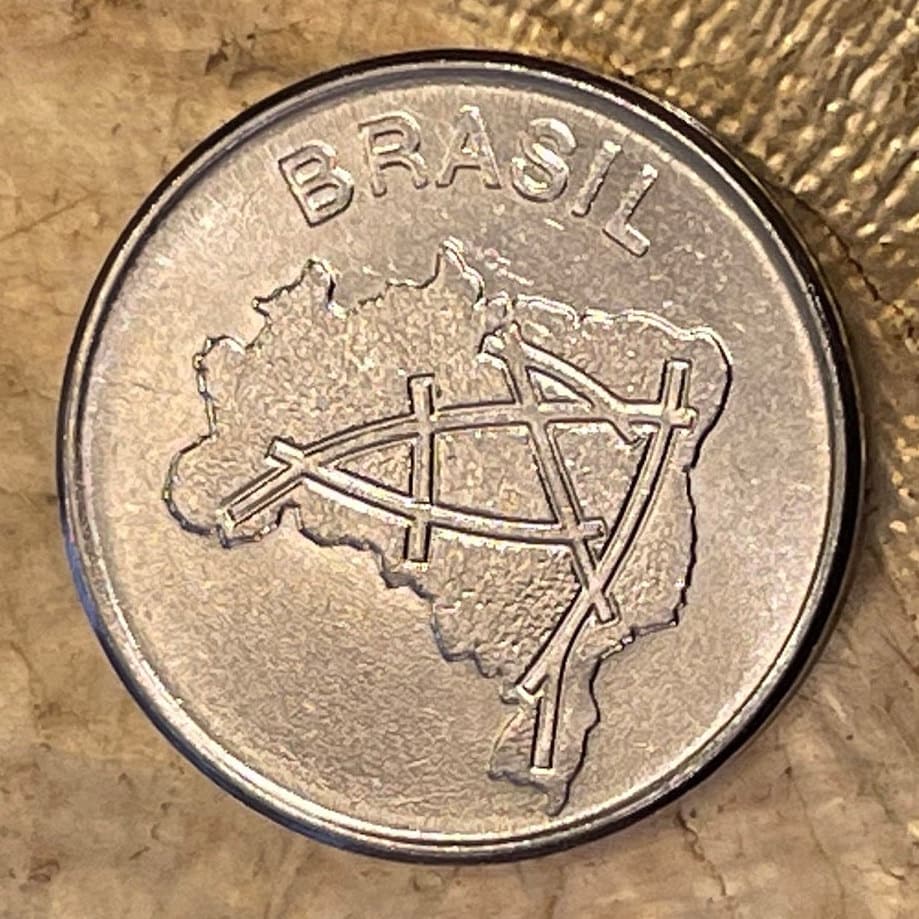elemintalshop
Brazil Highway Map 10 Cruzieros Brazil Authentic Coin Money for Jewelry and Craft Making (Long Distance Driving)
Brazil Highway Map 10 Cruzieros Brazil Authentic Coin Money for Jewelry and Craft Making (Long Distance Driving)
Couldn't load pickup availability
Brazil Highway Map 10 Cruzieros Brazil Authentic Coin Money for Jewelry and Craft Making (Long Distance Driving)
Obverse: Map of Brazil, featuring major highways.
Lettering: BRASIL
Translation: Brazil
Reverse: Value flanked by coffee bean, ribbon behind value.
Lettering: 10
CRUZEIROS
Features
Issuer Brazil
Period Federative Republic of Brazil (1967-date)
Type Standard circulation coin
Years 1980-1986
Value 10 Cruzeiros (10 BRB)
Currency Cruzeiro novo (1967-1986)
Composition Stainless steel
Weight 5.3 g
Diameter 24 mm
Thickness 1.6 mm
Shape Round
Orientation Coin alignment ↑↓
Demonetized 03-01-1986
Number N# 2241
References KM# 592, Schön# 101, Schön# 101a
Wikpedia:
The Brazilian Highway System (Portuguese: Sistema Nacional de Rodovias) is the highway system of Brazil. As of 2010, the system consists of almost 2 million kilometers of roads, of which approximately 200,000 km are paved.
As it is in the United States, Canada, or most countries in Europe, larger/wider highways have higher speed limits than normal urban roads (typically between 80 km/h and 120 km/h), although minor highways, unpaved highways and sections of major highways running inside urban areas have a lower speed limit in general. The national speed limit for cars driving in non-urban roads is 110 km/h unless otherwise stated, regardless of the road design, weather or daylight.
*********
Brazil Roads
2010
By Amelia Meyer
It is not generally recommended that tourists opt to travel and explore Brazil on the roads, by driving a motor vehicle. The reasons include, the state of the roads are not well maintained, the parking availability in cities is low, there is a great deal of distance between cities and locations of sight-seeing; but most of all because Brazil has the highest fatality in the world from driving related accidents. It is recognized that drivers in the Brazilian cities tend to be aggressive drivers who have disregard for road rules and this is a perfect set up for road accidents.
Road rage, tailgating and other forms of illegal driving do seem to be rife in Brazil. Truck drivers vary from having a safe regard and caution in road driving, to others that are known to be intoxicated or over-worked and therefore tired.
The constant need to be alert is heightened by the risk of stray animals on streets. Pedestrians and motorcycle riders also do not sometimes adhere to road rules.
The threat of being mugged at robot/light crossings is also common and many drivers try to always have their windows closed. This may perpetuate many drivers feeling hot and irritable, as most cars in Brazil lack air-conditioning.
Brazil has the fourth largest highway system in the world. The main route of transport of people and freight/cargo is via the highways. It is a fact that over 90% of the roads in Brazil are unpaved and this means that below 10% of Brazilian roads are paved roads.
The code for highways has a simple abbreviation; the regional high-ways are named by getting the two letters abbreviating the state and then three letters describing the highway.
As an example SP-123 tells us the highway is in São Paulo and is directed in a north-south direction. Brazilian National Highways are abbreviated BR with the three numbers following to describe the highway. As an example BR-241 informs us that the highway is a main one and that it is going in an east-west direction.
The maintenance of the highways tends to be a major concern, as the weather and heavy use on them causes much wear and tear. Potholes are issues on the roads. Toll roads are well utilized in Brazil to gain funding for the maintenance of the roads, the highest toll fees are set by private companies.
The government decided from the 1990s that it would grant private companies the authorization to administer and maintain parts of the highway; and in return have the right to charge at toll booths.
The national speed limit on non-urban roads is 110km/hour, unless otherwise stated. Highway speed limits can vary from 80km/hour to 120km/hour.
Some advice on driving on Brazilian roads:
•Read the U.S. Department of State Safety and Security Guidelines for Travelers to Brazil
• Try being a passenger before you actually drive in Brazil, to gain a sense of how motorists are and how the traffic works there
•Try learning basic Portuguese
• Try having a cell phone in your possession
•Where possible use public transport in major cities
•Try avoid driving during holiday periods
•Don't drink and drive.
•Avoid driving at night.
•Know Brazil traffic signs.
•Learn how to protect yourself from threats, avoid displaying valuable items on the dashboard or car seats
•Try improving defensive driving
•Learn about the road conditions and weather conditions, to be prepared
References:
https://www.hoteltravel.com/brazil/guides/transport.htm
https://en.wikipedia.org/wiki/Brazilian_Highway_System
https://gobrazil.about.com/od/healthsafety/a/driving.htm
https://en.wikipedia.org/wiki/Transport_in_Brazil
Source: https://www.brazil.org.za/brazil-roads.html
Share



















